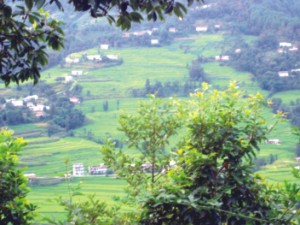|
Travel
Trekking in the Himalayas

The view down from Nagarkot.
Shara Azad
Since Nepal is right next to Bangladesh, it is not at all troublesome to travel from Dhaka to Kathmandu; in fact, it is rather a bit like flying to Chittagong since a visa is not even necessary for Bangladeshi passport holders. However, thanks to the easiness of travel, while Bangladeshis frequently go to Nepal, the question is: do they actually experience all the country has to offer? Besides temples and pashminas, there is much more to do and see in the Kathmandu valley, especially if one decides to venture out toward the Himalayas.
Even though like many Bangalis I have practically no hiking experience whatsoever and am the farthest thing from being on 'outdoor person' I thought it would be a great idea to go mountain trekking during a recent trip to Nepal. Deep down, I probably harbour some secret sentiment to be just like Sir Edmund Hillary and Tenzing Norgay, the first people to summit Mount Everest. However, while the Mount Everest expedition takes about two weeks and requires a fair bit of training, it is possible to do just a few hours of trekking and still have the Himalayan experience without the frostbite caused by the snow on the higher altitude peaks, so I opted for the latter alternative.
Finding a mountain trekking guide is not particularly difficult in Kathmandu since the city seems to be geared toward tourists stopping by before or after their mountain expedition. Of course, the peak season for mountain climbing and trekking, as I was repeatedly told by my guide, is in October, when there is limited cloud coverage in the Himalayas. Still, I was fortunately able to find a guide during the off-season, who arranged a seven-hour trekking trip for me from Nagarkot to the temple Changu Narayan in the foothills of the Himalayas.
 |
| A mountain cat |
Kathmandu valley |
A snapshot of the distant foothills of the Himalayas |
Trekking is quite the adventure for someone whose only daily exercise done is a frantic search for the television remote every morning. Days after my trek, I could still feel the lactic acid in my legs, built up from the prolonged walking and jumping I had to do over miniature streams and steep declines on the way downhill from Nagarkot. I learned a great deal about Nepalese culture and myths though, because my guide not only took me through the forests in the Himalayas, but also through the tiny villages that dot the hills. I happened to go on my trek on the very same day Nepal elected their prime minister, Prachanda. I would not have realised this fact if I had not read the newspaper that morning and seen the articles about strikes in cities, however, as people in the village seemed completely unaffected by the politics of the nation. For the tribes and villages of the Himalayas that I happened to see, life revolves around their farms and livestock. The only politics they experience is when a tribal group decides to take control of the land used for rice farms or someone misuses the temple, which was interesting because those villages were only an hour or two from Kathmandu, yet their lives were completely separate and simpler. It is quite possible that the people I saw in the villages did not even know their country had switched from a monarchy to a republic in the past year, they were just that detached from the happenings of the westernised capital city.

Some of the fauna and farms that encompass Nepal |
On the other hand, the villagers were incredibly kind. They offered me a bit of their local food, boiled potatoes and crushed green chilies, for lunch. I respectfully declined the potatoes but sampled a bit of Nepalese apple, which was a like a lot regular apple, though more fragrant and larger. According to my guide, the Himalayas are home to ten percent of the world's biodiversity, so the local people are able to enjoy a wide variety of fruits. In fact, during my trek I saw not only Nepalese apples growing in the wild, but also grapefruits, pears, cannabis, poinsettias, a yellow vine that apparently cures Hepatitis, and pumpkins, in addition to the plethora of animals I saw, such as buffalos, goats, snakes, finches, and cows, the national animal of Nepal.
Walking for seven hours is no easy feat, and by the end, I was plenty tired-so tired in fact, that I slept for ten hours when I returned and then took a long soak in the hotel Jacuzzi afterwards. Therefore, a word of advice to any future trekkers: make sure the lodgings have some sort of hot tub because your muscles will definitely need it! Luckily Kathmandu is chock full of spas to give the body the attention it deserves after a demanding yet fulfilling trek.
Copyright
(R) thedailystar.net 2008 |
|
